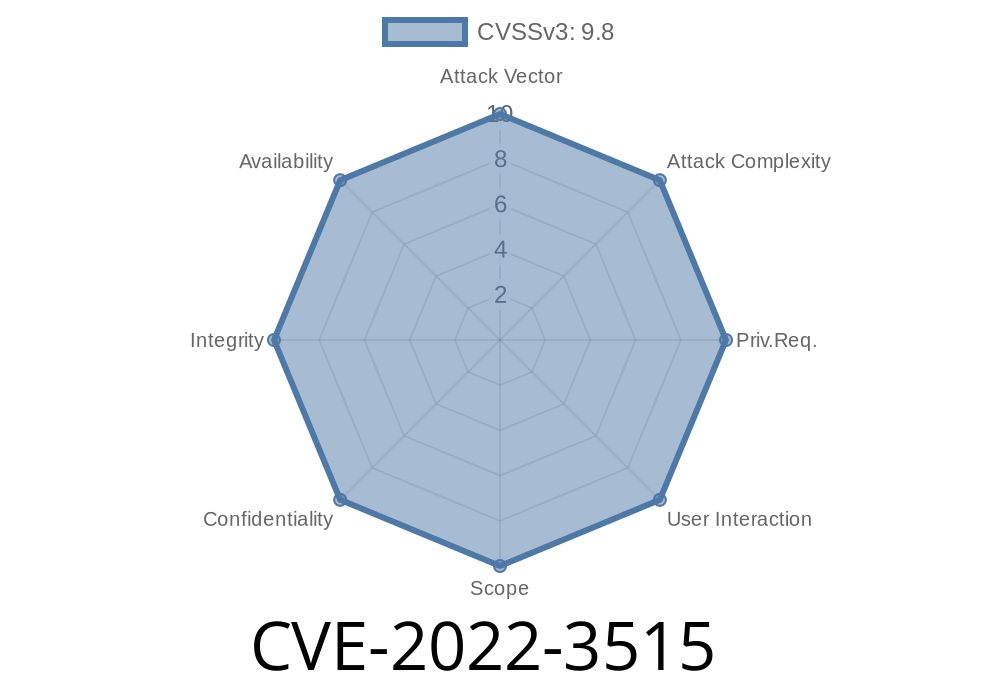In October 2022, a critical security issue was discovered in the Libksba library—a widely used open-source component responsible for parsing ASN.1 objects, used in applications involving S/MIME and X.509 certificates (like GnuPG and GpgSM). The issue, tracked as CVE-2022-3515, is an integer overflow vulnerability in the CRL parser that could be exploited remotely for arbitrary code execution. In this detailed post, we’ll explore the root of the vulnerability, demonstrate how it can be exploited, and provide references for further reading. All code snippets and explanations are written in simple, approachable language.
What is Libksba and Why Does This Matter?
Libksba is a low-level cryptography support library used by security and privacy tools, especially for parsing complex encryption data structures like those found in S/MIME email signatures and X.509 certificate validation. Many desktop email clients, certificate managers, and security utilities rely on Libksba for secure cryptographic parsing.
A vulnerability in Libksba means any application linked with it could be potentially at risk—even if the application itself is well-written.
What is CVE-2022-3515?
This specific bug is due to integer overflow in the part of the CRL (Certificate Revocation List) parser that processes lengths and extensions inside ASN.1-encoded data. Attackers can craft a malicious CRL file (or, for example, an S/MIME email attachment) with manipulated length fields that trigger memory corruption. This can lead to remote code execution (RCE) if the crafted data is opened or parsed by vulnerable software.
Discovered: October 2022
- Patched by upstream: October 27, 2022 (Libksba 1.6.2 release notes)
- CVE: NVD entry for CVE-2022-3515
Integer Overflow Vulnerability
The bug lies within the function that parses extensions in a CRL object. Specifically, the code does not properly handle size calculations when allocating memory for extension data—when a very large length value is parsed, the arithmetic wraps around (overflows), causing too little memory to be allocated.
Let’s illustrate a simplified version of the vulnerable code
// Vulnerable snippet from ksba_crl_parse_ext()
// Simplified for illustration
if (ext_len > ) {
ext = xtrymalloc(sizeof(*ext) + ext_len - 1); // <- integer overflow risk
if (!ext) return out_of_core ();
// ... copy extension data ...
}
Suppose ext_len is a large value (like xFFFFFFFF). The subtraction and addition can overflow the size calculation, resulting in a much smaller buffer than expected, which can then be overrun by the copy operation. This buffer overflow can potentially be exploited to execute arbitrary code.
Let’s walk through a real-world attack scenario
1. Craft a Malicious CRL File: Use or write a tool to generate a CRL file (or S/MIME attachment) with ASN.1 encoding, placing a huge length value in a CRL extension.
2. Send or Deliver the File: The attacker lures a target into opening the malicious file using a vulnerable email client or certificate validation software (for example, by sending an S/MIME-signed email).
3. Trigger Vulnerable Code: When the application parses the CRL, the overflow occurs, corrupting memory and executing attacker-controlled payload.
4. Remote Code Execution: The attacker can now potentially run arbitrary code as the user running the parsing application.
### Exploit Example: Crafting a Malicious S/MIME CRL
While a full, working exploit is not publicly available, this is a rough example (in Python) of how an attacker could craft a bogus CRL section with a dangerous length field.
# WARNING: This is for educational demonstration only!
# Creates an ASN.1-encoded CRL with an extension of massive length.
with open("evil.crl", "wb") as f:
# ASN.1 header for a CRL (very basic/fake)
f.write(b'\x30\x82\x01\x00') # SEQUENCE, length x100
f.write(b'\xA\x84\xFF\xFF\xFF\xF') # Context-specific tag + huge length
f.write(b'A' * 32) # Garbage, for demonstration
# Ideally, encode a real CRL structure... left as exercise
A real attacker would need to generate a valid CRL structure so that vulnerable applications actually attempt to parse it. This sample demonstrates writing an invalid, oversized length that could cause the vulnerable allocation.
Who is Affected?
Any software that links against Libksba < 1.6.2 and parses untrusted S/MIME, X.509, or CRL data is affected. This includes:
GnuPG and GpgSM: Used to verify and manage cryptographic signatures.
- Email Clients: Like Evolution or KMail with S/MIME support.
Defense and Mitigation
Upgrade immediately. The only reliable fix is to upgrade to Libksba 1.6.2 or newer, which includes the patch to check for integer overflows and properly handle size calculations.
- For end users: Update your system using your Linux distribution’s package manager, or download directly from gnupg.org.
For developers: Audit all software dependencies for use of Libksba and adjust version constraints.
Reference patch:
- Upstream libksba patch
+ if (buflen > MAX_CRLFIELD || (sizeof(*ext) + buflen - 1) < buflen)
+ return gpg_error (GPG_ERR_TOO_LARGE);
Key Takeaways
- CVE-2022-3515 is a remote code execution vulnerability due to integer overflow in Libksba CRL parser.
- Attackers can exploit this using a malformed S/MIME or CRL file, risking compromise just by opening an email or certificate.
Further Reading and References
- NVD Entry for CVE-2022-3515
- Libksba 1.6.2 Announcement
- Debian Security Tracker Entry
- Upstream Patch
- GnuPG Libksba Project
Stay secure: Keep your cryptographic libraries up to date, and always treat files from untrusted sources with caution—especially when security software is involved.
Timeline
Published on: 01/12/2023 15:15:00 UTC
Last modified on: 05/18/2023 18:08:00 UTC
